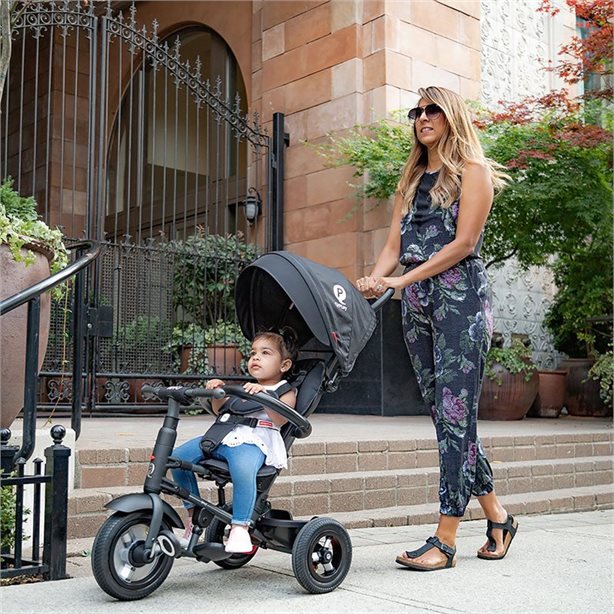Stroller safety starts with choosing the right stroller for your baby. Know what to consider when looking for a stroller and how to keep your baby safe on the go.
By Mayo Clinic Staff
If you're like most parents, you'll likely get at least one stroller for your baby. With so many designs and types of strollers, however, how do you choose? Understand how to pick the best stroller for your baby and important stroller safety tips.
What should I consider when looking for a stroller?
When looking at strollers for your baby, consider:
Your location.If you live in or near a city, you'll likely need a sturdy stroller to maneuver along sidewalks. You might also need to be able to collapse your stroller in a pinch to get on a bus or subway. Suburban parents might want a stroller that's easy to fold and fits into the trunk of a vehicle.
Your family.If you have an older child, you might want a double stroller or a stroller with an attachment for an older child. If you'll be using an attachment, be sure to read the manufacturer's weight guidelines.
Your lifestyle.An umbrella stroller might be useful for running errands or traveling. Plan to take your baby along on your runs? You might look for a jogging stroller, too.
Do you want your baby's stroller to have a storage basket, rain cover, blanket, sun shade or cup holder? Some strollers aren't compatible with certain accessories.
What type of stroller is safe for a newborn?
If you plan to use a stroller for your newborn, make sure that the stroller reclines — since newborns can't sit up or hold up their heads. Some strollers fully recline or can be used with a bassinet attachment or an infant-only car seat. Most umbrella strollers, however, don't provide adequate head and back support for young babies.
Also, most jogging strollers aren't designed to recline. As a result, they aren't appropriate for babies until about age 6 months.
What do I need to know about travel systems?
If you have a car, you might look for a stroller that can hold your baby's car seat. Some car seats and strollers come in matching sets, while others require separate attachments that allow the strollers to be used with certain car seats. Once you strap your baby into his or her car seat, these kinds of strollers will allow you to easily move your baby between the stroller and car.
If you use a travel system that allows you to move your baby's car seat from your vehicle to a stroller base, you might be tempted to let your baby finish car naps in the car seat. However, sitting in a car seat for lengthy periods can contribute to the development of a flat spot on the back of your baby's head, worsen gastroesophageal reflux disease (GERD) and affect a child's breathing. Experts suggest not letting your child sleep or relax in the car seat for more than two hours.
What if my baby has special needs?
If your baby was born prematurely or has health concerns, you might want a stroller with storage that will help you carry any necessary equipment, such as a cardiac monitor or oxygen. Parents of babies who have similar health concerns might be a good source of advice.
What other features should I look for?
Consider checking for safety features, including:
Practical brakes.Look for a stroller that has brakes that are easy to operate. Some strollers have brakes that lock two wheels — a special safety feature. Make sure your baby can't reach the brake release lever.
A wide base.Strollers that have wide bases are less likely to tip over.
A single footrest.If you're looking for a side-by-side double stroller, choose one with a single footrest that extends across both sitting areas. Small feet can get trapped between separate footrests.
How can I keep my baby safe in his or her stroller?
To prevent stroller accidents:
Stay close.Don't leave your baby unattended in his or her stroller.
Be careful with toys.If you hang toys from a stroller bumper bar to entertain your baby, make sure that the toys are securely fastened.
Buckle up.Always buckle your baby's harness and seat belt when taking him or her for a stroller ride.
Use your brakes.Engage your stroller brakes whenever you stop the stroller.
Properly store belongings.Don't hang a bag from the stroller's handle bar, which can make a stroller tip over.
Take caution when folding.Keep your baby away from the stroller as you open and fold it, since small fingers can get caught in stroller hinges. Always make sure the stroller is locked open before you put your child in it.
Keep it out of the sun.During hot weather, don't let your baby's stroller sit in the sun for long periods of time. This can cause plastic and metal pieces to become hot enough to burn your baby. If you leave the stroller in the sun, check the stroller's surface temperature before placing your baby in the stroller.
Check for recalls.Return the stroller warranty card so that you'll be notified in case of a recall. If you're considering a used stroller, make sure the stroller hasn't been recalled.






























Leave a comment
This site is protected by hCaptcha and the hCaptcha Privacy Policy and Terms of Service apply.